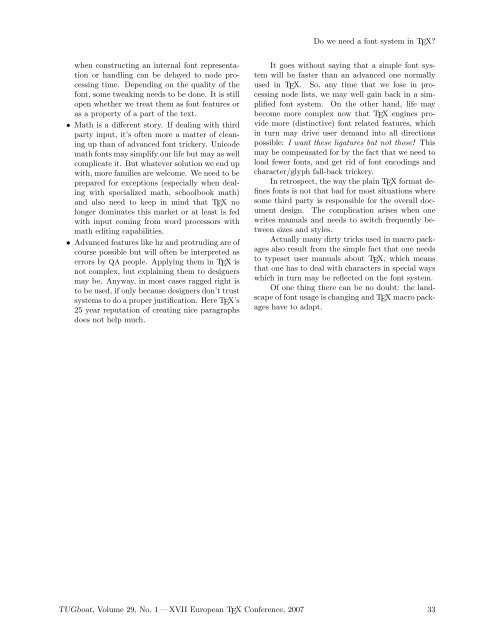Complete issue 29:1 as one pdf - TUG
Complete issue 29:1 as one pdf - TUG
Complete issue 29:1 as one pdf - TUG
You also want an ePaper? Increase the reach of your titles
YUMPU automatically turns print PDFs into web optimized ePapers that Google loves.
Do we need a font system in TEX?<br />
when constructing an internal font representation<br />
or handling can be delayed to node processing<br />
time. Depending on the quality of the<br />
font, some tweaking needs to be d<strong>one</strong>. It is still<br />
open whether we treat them <strong>as</strong> font features or<br />
<strong>as</strong> a property of a part of the text.<br />
• Math is a different story. If dealing with third<br />
party input, it’s often more a matter of cleaning<br />
up than of advanced font trickery. Unicode<br />
math fonts may simplify our life but may <strong>as</strong> well<br />
complicate it. But whatever solution we end up<br />
with, more families are welcome. We need to be<br />
prepared for exceptions (especially when dealing<br />
with specialized math, schoolbook math)<br />
and also need to keep in mind that TEX no<br />
longer dominates this market or at le<strong>as</strong>t is fed<br />
with input coming from word processors with<br />
math editing capabilities.<br />
• Advanced features like hz and protruding are of<br />
course possible but will often be interpreted <strong>as</strong><br />
errors by QA people. Applying them in TEX is<br />
not complex, but explaining them to designers<br />
may be. Anyway, in most c<strong>as</strong>es ragged right is<br />
to be used, if only because designers don’t trust<br />
systems to do a proper justification. Here TEX’s<br />
25 year reputation of creating nice paragraphs<br />
does not help much.<br />
It goes without saying that a simple font system<br />
will be f<strong>as</strong>ter than an advanced <strong>one</strong> normally<br />
used in TEX. So, any time that we lose in processing<br />
node lists, we may well gain back in a simplified<br />
font system. On the other hand, life may<br />
become more complex now that TEX engines provide<br />
more (distinctive) font related features, which<br />
in turn may drive user demand into all directions<br />
possible: I want these ligatures but not those! This<br />
may be compensated for by the fact that we need to<br />
load fewer fonts, and get rid of font encodings and<br />
character/glyph fall-back trickery.<br />
In retrospect, the way the plain TEX format defines<br />
fonts is not that bad for most situations where<br />
some third party is responsible for the overall document<br />
design. The complication arises when <strong>one</strong><br />
writes manuals and needs to switch frequently between<br />
sizes and styles.<br />
Actually many dirty tricks used in macro packages<br />
also result from the simple fact that <strong>one</strong> needs<br />
to typeset user manuals about TEX, which means<br />
that <strong>one</strong> h<strong>as</strong> to deal with characters in special ways<br />
which in turn may be reflected on the font system.<br />
Of <strong>one</strong> thing there can be no doubt: the landscape<br />
of font usage is changing and TEX macro packages<br />
have to adapt.<br />
<strong>TUG</strong>boat, Volume <strong>29</strong>, No. 1 —XVII European TEX Conference, 2007 33

















